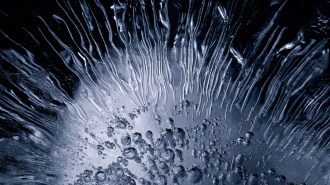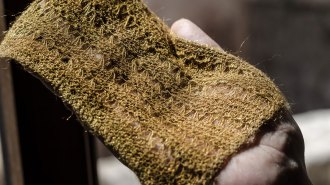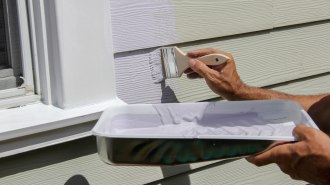Concrete Nation
Bright future for ancient material
- More than 2 years ago
Each year, billions of tons of concrete become the stuff of buildings, highways, dams, sidewalks, and even artworks. The list goes on. Not only is the material ubiquitous, it has a long history. The Romans invented cement-based concrete more than 2,000 years ago and used the material to build architectural masterpieces such as the Pantheon. To Christian Meyer, a structural engineer at Columbia University, there’s just no question about it: “Concrete is the world’s most important material.”
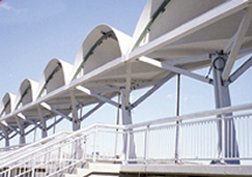

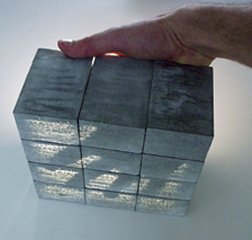

And it’s one of the simplest. A typical mix of concrete consists of 60 to 75 percent sand and gravel or crushed stone, 15 to 20 percent water, and 10 to 15 percent cement, which is prepared by roasting limestone, clay, and other ingredients. The cement is the paste that binds the components into concrete.
There are many simple ways to modify the properties of concrete. Tweaking the ratio of the ingredients can change the material’s strength or roughness, for instance. Modern concrete also contains chemical additives that affect the material’s physical properties, such as the fluidity or the time it takes to harden.
Scientists and architects have been pushing the limits of this humdrum material to give it new features and creative functions. “Liquid Stone,” a current exhibit at the National Building Museum in Washington, D.C., portrays the future of concrete. The show includes ultrahigh-performance concrete that bends like metal and another type of concrete that forms translucent blocks.
In pursuit of environmentally friendly construction materials, engineers are also giving concrete a hard look. Already among the most essential construction materials, concrete now seems poised to take on new roles.
More muscle
Major suppliers of construction materials take a pragmatic approach to improving concrete. These firms are coming up with a stream of new mixtures, such as ultrahigh-performance, corrosion-resistant, longer-lasting concrete. “The future will see an increased use of [these materials],” says Steve Kosmatka of the Portland Cement Association in Skokie, Ill.
For instance, consider some of the new materials developed by concrete giant Lafarge, headquartered in Paris. “Governments are finding they’re having to spend more and more on maintaining their infrastructure,” says Vic Perry of Lafarge North America. “That means you need to build things that last longer and are cheaper to maintain.” He’s talking about big things: bridges, highways, and buildings.
Perry leads the company’s North American operation producing Ductal, one of Lafarge’s newest concrete products. Unlike regular concrete, which is brittle and can rupture suddenly under a heavy load, Ductal can bend. “It will deflect and show signs of cracking before it fails,” says Perry. “You can see in advance that you’ve got a problem.”
What’s more, Ductal is five times as strong as regular concrete. That extra oomph comes from the addition of small fibers dispersed throughout the matrix. These fibers, made of either steel or polymer, reinforce the concrete and eliminate the need for reinforcing steel bars, or rebar. A bridge made out of Ductal can be lighter and thinner than a traditional bridge, Perry says.
Eliminating the need for steel bars has other advantages, including lengthening the lifetime of structures. Consider the deck of a bridge. In the winter, when ice-clearing salt dissolves and seeps into the concrete, it corrodes the steel. The corrosion causes the concrete to detach itself from the reinforcing metal and to crack. A conventional concrete deck needs major repairs or reconstruction after about 25 years, says Perry. “A Ductal deck should last at least twice as long,” he adds.
The material has already found its way into several pedestrian bridges around the world, as well as a light rail transit station in Calgary, Alberta. The canopies that form the roof over the station’s platform and the roof’s support columns are made entirely of Ductal. The canopies provide protection from the elements, can withstand high winds, and support heavy snow loads.
The labor market is another driving force behind concrete innovations. Many people in the industry are anticipating or already witnessing a shortage of laborers who mix, pour, and otherwise work with concrete. The average age of these workers is increasing as few young people enter the field. “So, you have to look at new methods and materials to reduce the amount of labor needed to build things,” says Perry.
In response to this concern, Lafarge has developed Agilia. According to the company, laying a 60-cubic-meter slab of regular concrete—enough for a floor in an office building—requires eight people and takes about 8 hours. Placing the same-size slab of Agilia could require as few as two people and take a couple of hours.
Normally, after concrete is poured, the mason passes a vibrating machine over the surface to squeeze out all the air bubbles. It’s a loud and time-consuming process. However, Agilia contains a mix of additives: superplasticizers that keep the concrete fluid and other chemicals that cut down on the water needed. These enable the concrete to consolidate under its own weight without mechanical vibration.
Because the self-consolidating concrete flows when poured, it can fill intricate molds and wrap around complex structures all the while leaving a smooth finish. The increased fluidity also makes the material ideal for construction in areas of high seismic activity, where structures usually are heavily reinforced with rebar, says Jack Holley, vice president for new product development at Lafarge North America. Trying to use vibration to consolidate standard concrete riddled with a mesh of rebar can be awkward, if not impossible, he says.
Let it shine
Ductal and Agilia may be high-tech, but they’re destined for concrete’s primary role as a structural material. Will Wittig, who teaches architecture at the University of Detroit Mercy in Michigan, wanted to take this “heavy and monolithic” construction material and turn it into something “more ethereal.” So, he set out to make concrete translucent.
Says Wittig: “I wanted to challenge our assumptions about what concrete is or what it can do.”
In pursuit of that goal, Wittig mixed white silica sand and white Portland cement, varying the ratios to get a paste that cures in thinner preparations than standard concrete mixes do. He added short strands of fiberglass to reinforce the material.
Next, Wittig built a table topped with a Plexiglas square mold into which he poured his concrete mixture. He made a number of prototypes, always pushing for panels that were thinner, but not so thin that they would break. The final concrete panels were thin as a coin at the centers and close to a centimeter thick at the edges.
The panels were originally meant as a shell for a one-room garden house that Wittig had designed several years ago. “My hope was that [the panels] would be translucent enough so that on a sunny day, you could sit inside and have enough light to read a book,” says Wittig.
His thinnest sheets of the new concrete transmit about 1 percent of sunlight. That would be in the ballpark of providing sufficient light to create a glow inside the structure, says Wittig. However, he never built the building—lab tests showed that the panels were too fragile to withstand wind and rain.
Instead of making concrete itself translucent, a small company in Germany is taking a different tack: incorporating transparent materials into the concrete. LiTraCon, based in Aachen, has developed a concrete that contains glass optical fibers the thickness of a hair. They transmit light from one side of the material to the other. Hungarian architect Áron Losonczi—who, like Wittig, experiments with construction materials—invented the translucent concrete.
To ensure that the ends of each fiber make contact with the surfaces on both sides of the material, blocks of concrete are built in stages. First, a thin layer of concrete is poured into a long, narrow mold. Then, a layer of optical fibers is laid along the length of the mold. After several repetitions, the resulting long beam can be cut into short, rectangular building blocks riddled with the thin light pipes, says LiTraCon’s Andreas Bittis.
The fiber diameters range from 2 microns to 2 millimeters. By using fibers of different diameters, LiTraCon designers can achieve different illumination effects. Varying the size of the blocks, however, doesn’t change the effect. So far, LiTraCon has made continuous concrete beams up to 20 meters long, and the fibers transmit light the entire length.
With these blocks, architects can design and build a large variety of structures, ranging from translucent concrete walls to floors lit from below. LiTraCon has already received a number of requests from architects interested in the material, says Bittis. One firm in New York has proposed using the new concrete in its design of a police college in Kuwait City. Because concrete is an excellent insulating material, the building would protect against the desert heat while letting through some sunshine.
Concrete cleanup
Although some new types of concrete might be taking on ethereal traits, traditional concrete continues to weigh very heavily on the planet. Each year, the United States alone lays down 500 million tons of concrete. “That has a tremendous impact on the environment,” says Columbia University’s Christian Meyer. Sand, gravel, or crushed stone are extracted from natural resources. “Entire mountains can be taken away to satisfy the voracious appetite of the concrete industry,” says Meyer.
Another enormous toll on the environment comes from the carbon dioxide—one of the main global warming gases—released during cement production. Heating limestone and clay at high temperatures requires burning a substantial amount of fossil fuel. Also, carbon dioxide is released from a chemical reaction that occurs when the limestone and clays are combined.
The production of a ton of Portland cement—the most common type—releases about a ton of carbon dioxide into the atmosphere, says Meyer. The cement industry contributes 7 percent of the global human production of carbon dioxide, he adds.
Meyer has been active in promoting the so-called green building movement. Much of his research focuses on ingredients, mainly recycled materials that can substitute for the traditional components of concrete. For instance, his group has made a glass-based concrete by replacing all or part of the sand and gravel elements with crushed recycled glass.
Normally, when glass is mixed with cement, the cement’s alkali reacts with the glass’ silica. This creates a gel in the final product that swells in the presence of moisture and cracks the concrete. The Columbia group replaced part of the cement with the clay mineral metakaolin, which absorbs the alkali ions so that they don’t react with the silica. Wausau Tile of Wausau, Wis., licensed Meyer’s concrete-glass invention and is now producing colorful floor tiles made with recycled glass.
To replace the entire cement component of concrete, Meyer is looking at yet another unlikely source: dredged material from New York City harbor. The Port Authority scoops out material from the harbor to keep the shipping lanes open. Instead of dumping vast amounts of the material in a landfill, Meyer is working on ways of blending the dredged products into concrete after treating the hazardous ingredients to render them harmless.
Surprisingly, his group has found that various properties of the clay minerals in dredged harbor sediment are superior to those of clay minerals on land. In preliminary tests, the researchers found that concrete mixed with dredged material could survive 100 times as many freeze-thaw cycles as concrete without the dredged substance can.
New forms of concrete might also abate environmental pollution. Scientists at the Italcementi Group in Bergamo, Italy, have developed a self-cleaning concrete that keeps buildings from turning black from pollutants in the atmosphere. Luigi Cassar and his colleagues at the research branch of Italcementi made the concrete by adding particles of the white pigment titanium dioxide to the cement component.
When titanium dioxide absorbs ultraviolet light, it becomes highly reactive and breaks down pollutants that come into contact with the concrete’s surface. The reactive material can kill bacteria and fungi and also break down pollutants such as nitric oxide, sulfur dioxide, and many volatile organic compounds that contribute to concrete’s darkening.
The self-cleaning concrete has already been used in several new buildings, including a modern church in Rome called the Dives in Misericordia. “The goal was to create a material for a church that would last, say 1,000 years, and to have a surface that remains the same color,” says Cassar.
The material has applications beyond keeping concrete surfaces bright. Cassar’s group has found that the concrete can actually clean the air. The company is investigating coating buildings and roads with the photocatalytic material. Computer models of the material and urban pollution predict that covering 10 to 15 percent of the roads and building surfaces in a city such as Milan, Italy could reduce air pollution by 40 to 50 percent, Cassar’s group calculates.
The pursuit of improved concrete materials continues. How much of the world adopts these new types of concrete depends on numerous factors, including whether the materials meet technical needs, how much they cost, and whether big-time architects and designers adopt them.
The efforts to bring concrete to new heights of function and form, however, is almost certain to transform the traditional perception of concrete as a cold, drab, low-tech material. Its use is likely to extend as far into the future as it reaches into the past.


